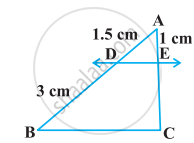Advertisements
Advertisements
Question
In the given figure, BC is parallel to DE. Area of triangle ABC = 25 cm2, Area of trapezium BCED = 24 cm2 and DE = 14 cm. Calculate the length of BC. Also, find the area of triangle BCD.

Solution
In ΔABC and ΔADE,
As BC || DE, corresponding angles are equal
∠ABC = ∠ADE
∠ACB = ∠AED
ΔABC ~ ΔADE
∴ `(ar(ΔABC))/(ar(ΔADE)) = (BC^2)/(DE^2)`
`25/49 = (BC^2)/14^2`
(ar(∆ADE) = ar(∆ABC) + ar(trapezium BCED))
BC2 = 100
BC = 10 cm
In trapezium BCED,
Area = `1/2 ("Sum of parallel sides") xx h`
Given: Area of trapezium BCED
= 24 cm2, BC = 10 cm, DE = 14 cm
∴ `24 = 1/2(10 + 14) xx h`
`=> h = 48/((10 + 14))`
`=>h = 48/24`
`=>` h = 2
Area of ΔBCD = `1/2 ` × base × height
= `1/2 xx BC xx h`
= `1/2 xx 10 xx 2`
∴ Area of ∆BCD = 10 cm2
APPEARS IN
RELATED QUESTIONS
In figure, ∠CAB = 90º and AD ⊥ BC. If AC = 75 cm, AB = 1 m and BD = 1.25 m, find AD.
See the given figure. DE || BC. Find EC.

Using Basic proportionality theorem, prove that a line drawn through the mid-points of one side of a triangle parallel to another side bisects the third side. (Recall that you have proved it in Class IX).
In the given figure, if ∠ADE = ∠B, show that ΔADE ~ ΔABC. If AD = 3.8cm, AE = 3.6cm, BE = 2.1cm and BC = 4.2cm, find DE.
In an isosceles ΔABC, the base AB is produced both ways in P and Q such that
AP × BQ = AC2.
Prove that ΔACP~ΔBCQ.

AD and BC are two straight lines intersecting at 0. CD and BA are perpendirulars from Band Con AD. If AB=6cm, CD =9cm, AD =20cm and BC=25cm, find the lengths of AO, BO, CO and DO.
In ΔABC, point D divides AB in the ratio 5:7, Find: DE, If BC = 4.8cm
On a map drawn to a scale of 1:25000, a triangular plot of land is right angled and the sides forming the right angle measure 225cm and 64cm.Find: The area of the plot in sq. km.
Two triangles QPR and QSR, right angled at P and S respectively are drawn on the same base QR and on the same side of QR. If PR and SQ intersect at T, prove that PT × TR = ST × TQ
Write the test of similarity for triangles given in figure.
